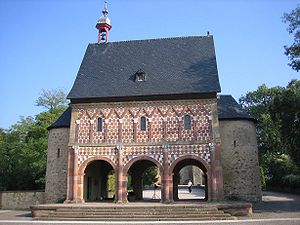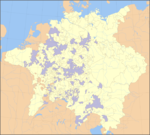- Lorsch Abbey
-
Abbey and Altenmünster of Lorsch * UNESCO World Heritage Site
Country Germany Type Cultural Criteria iii, iv Reference 515 Region ** Europe and North America Inscription history Inscription 1991 (15th Session) * Name as inscribed on World Heritage List
** Region as classified by UNESCOImperial Abbey of Lorsch
Reichsabtei LorschImperial Abbey of the Holy Roman Empire ← 
852–1232  →
→Coat of arms
Capital Lorsch Abbey Government Theocracy Historical era Middle Ages - Founded by Count Cancor 764 - Codex Aureus produced 778–820 - Immediacy confirmed 852 - Gorze Reforms 10th century - Lorsch codex produced 1175–95 - Granted to Mainz by
Pope Gregory IX and
Emp. Frederick II
1232- Razed by French troops
during Nine Years' War
1679–97Today part of  Germany
GermanyThe Abbey of Lorsch (German: Reichsabtei Lorsch; Latin: Laureshamense Monasterium, called also Laurissa and Lauresham) is a former Imperial Abbey in Lorsch, Germany, about 10 km east of Worms, one of the most renowned monasteries of the Carolingian Empire. Even in its ruined state, its remains are among the most important pre-Romanesque–Carolingian style buildings in Germany. Its chronicle, entered in the Lorscher Codex compiled in the 1170s (now in the state archive at Würzburg) is a fundamental document for early medieval German history. Another famous document from the monastic library is the Codex Aureus of Lorsch. In 1991 the ruined abbey was listed as a UNESCO World Heritage Site.[1]
Contents
Historic names
The following historical names have been recorded:
- In the 9th century: Lorishaim
- 9th and 11th centuries: Loresham
- 9th–10th centuries: Laurishaim
- 10th century: Laresham
- 10th–12th centuries: Lareshaeim and Lauresheim
- 11th–12th centuries: Lauresham
- 11th century: Larsem, Loraszam, Lorozam, Lorisham
- 12th century: Laurisca, Laurisham, Laureshan, Loressam, Lorisheym, Lorscheim, Lors
History
The abbey was founded in 764 by the Frankish Count Cancor and his widowed mother Williswinda as a proprietary church (Eigenkirche) and monastery on their estate, Laurissa. They entrusted its government to Cancor's nephew Chrodegang, Archbishop of Metz, who dedicated the church and monastery to Saint Peter and became its first abbot. The pious founders enriched the new abbey by further donations. In 766 Chrodegang resigned the office of abbot, in favour of his other duties as Archbishop of Metz. He then sent his brother Gundeland to Lorsch as his successor, with fourteen Benedictine monks. To make the abbey popular as a shrine and a place of pilgrimage, Chrodegang obtained from Pope Paul I the body of Saint Nazarius, martyred at Rome with three companions under Diocletian. On 11 July 765, the sacred relics arrived, and with great solemnity were deposited in the basilica of the monastery. The abbey and basilica were then renamed in honour of Saint Nazarius: the main church of Saints Peter, Paul, and Nazarius was consecrated by the Archbishop of Mainz in 774, in the presence of Charlemagne.
Many miracles were said to be wrought through the intercession of Saint Nazarius at Lorsch, and from all parts of Europe pilgrims in large numbers came to visit the shrine. In the course of the ninth century the library and scriptorium of Lorsch made it one of the cultural centres of Germany; its four surviving ninth-century catalogues show that it was rich in both Classical and Christian texts.[2] Few Carolingian manuscripts are better known than the Lorsch gospels, the Codex Aureus of Lorsch, now divided between the Vatican Library and Biblioteca Batthyaneum, Alba Iulia, Romania; the carved ivory consular diptychs of Anastasius (consul 517) that were reused for its bindings are urbane classicising works of art in themselves, and embodiments of the classical tradition of Byzantium as it was transmitted to Lorsch in the time of Charlemagne.[3]
Popes and emperors repeatedly favoured the abbey with privileges and estates ranging from the Alps to the North Sea, so that in a short time it became not only immensely rich, but also a seat of political influence. It was declared a Reichsabtei (a sovereign principality in its own right, subject directly and solely to the emperor. The abbey's importance is highlighted by the fact that two Carolingian kings, Louis the German and Louis the Younger, were buried there.
 Opening page of the Lorsch Codex, a codex in Carolingian minuscule that details the Lorsch land holdings
Opening page of the Lorsch Codex, a codex in Carolingian minuscule that details the Lorsch land holdings
The abbey, enjoying sovereign territorial rights, became implicated in several local feuds and in a number of wars. After forty-six abbots of the Benedictine Order had governed the abbey, Conrad, the last of the abbots, was deposed by Pope Gregory IX in 1226, and through the influence of Frederick II, Lorsch came into the possession of Siegfried III, Archbishop of Mainz, in 1232, ending the great period of Lorsch's cultural and political independence.
In 1248 Premonstratensian monks were given charge of the monastery with the sanction of Pope Celestine IV, and they remained there till 1556, when Lorsch and the surrounding country passed into the hands of Lutheran and Calvinist princes. The Elector Palatine Otto Heinrich removed the contents of the library to Heidelberg, forming the famous Bibliotheca Palatina, just prior to Lorsch's dissolution in 1557/1563. The remaining religious inhabitants of the abbey were pensioned and sent away. In 1623, after the capture of Heidelberg, the Elector Maximilian of Bavaria presented the splendid library, 196 cases of manuscripts, to Pope Gregory XV.[4] Leo Allatius was sent to superintend its removal to Rome, where it was incorporated into the Vatican library as the "Biblioteca Palatina".
During the Thirty Years' War Lorsch and its neighbourhood suffered greatly. In 1621 most of the buildings at Lorsch were pulled down. After the Archbishopric of Mainz regained possession of it, the region was returned to the Catholic faith. The most dreary period for Lorsch was during the wars of Louis XIV of France, 1679–97. Whole villages were laid in ruins, the homes of the peasantry were destroyed by fire, and the French soldiers burned the old abbey buildings. One portion, which was left intact, served as a tobacco warehouse in the years before World War I. The ancient entrance hall, the Königshalle (illustration, above), built in the ninth century by Emperor Louis III, is the oldest and probably the most beautiful monument of Carolingian architecture.
See also
Notes
- ^ Abbey and Altenmünster of Lorsch on the UNESCO Register of World Heritage Sites
- ^ James W. Thompson, The Medieval Library (New York) 1957, pp 80-82; Chauncey E. Finch, "Catalogues and Other Manuscripts from Lorsch" Transactions and Proceedings of the American Philological Association 99 (1968) pp. 165-179.
- ^ Margaret H. Longhurst and Charles Rufus Morey, "The Covers of the Lorsch Gospels", Speculum 3.1 (January 1928:64-74); Charles Rufus Morey, " The Covers of the Lorsch Gospels", Speculum 4.4 (October 1929):411-429).
- ^ Thompson 1957; Finch 1968:165.
References
 This article incorporates text from a publication now in the public domain: Herbermann, Charles, ed (1913). "Lorsch Abbey". Catholic Encyclopedia. Robert Appleton Company.
This article incorporates text from a publication now in the public domain: Herbermann, Charles, ed (1913). "Lorsch Abbey". Catholic Encyclopedia. Robert Appleton Company.
External links
 Media related to Abbey and Altenmünster of Lorsch at Wikimedia Commons
Media related to Abbey and Altenmünster of Lorsch at Wikimedia Commons- Official website (German)
- Codex Laureshamensis, volume 1–3 Charters of abbey Lorsch in Latin at Austrian literature online edited by Karl Glöckner, Darmstadt 1929-1936.
- Interactive map of the property of abbey Lorsch at Regnum Francorum Online
 Holy Roman Empire — Imperial abbeys of the Swabian College
Holy Roman Empire — Imperial abbeys of the Swabian CollegeImperial abbeys and colleges
(Reichsabteien, Reichsklöster
und Reichsstifte)Baindt • Comburg • Disentis • Elchingen • Frauenchiemsee • Fraumünster • Fürstenfeld • Gengenbach • Göss • Gutenzell • Heggbach • Helmarshausen • Herrenalb • Irsee • Kaisheim† • Lindau • Lorsch • Marchtal • Marmoutier • Maulbronn • Mönchrot • Mondsee • Murbach* • Neresheim • Ochsenhausen • Ottobeuren • Petershausen • Prüfening • Reichenau • Roggenburg • Rottenmünster • St. Gall's* • St. George's in Isny • Salem • Schänis • Schussenried • Schuttern • Söflingen • Ursberg • Waldsassen • Weingarten • Weissenau • WettenhausenImperial charterhouse
(Reichskartause)- Also a Prince of the Empire † Also in Rhenish College
Categories:- Imperial abbeys
- Former theocracies
- Former countries in Europe
- States of the Holy Roman Empire
- World Heritage Sites in Germany
- Benedictine monasteries in Germany
- Premonstratensian monasteries in Germany
- Monasteries in Hesse
- 764 establishments
- 770s architecture
- Carolingian architecture
- Franks
- Kreis Bergstraße
- Christian monasteries established in the 8th century
- Museums in Hesse
- Religious museums in Germany
Wikimedia Foundation. 2010.



